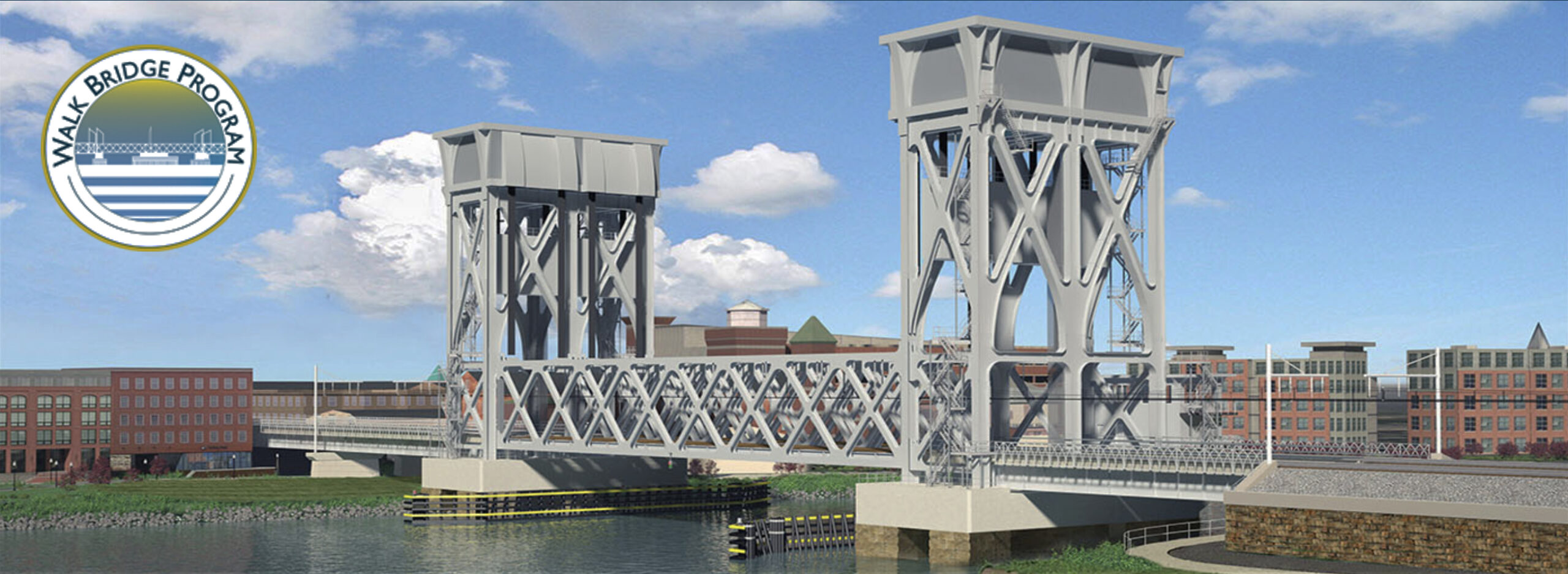
2021 – 2026: Five+ Years of East Norwalk Construction, Road Closures & Traffic Detours
Don’t let the project named “Walk Bridge” fool you! For East Norwalkers, the replacement of the aging Metro North expanse across the Norwalk River is almost the least of our concerns.
So what SHOULD we pay attention to?
The rest of the project, which includes the replacement of all the Metro North Bridges here (except Strawberry Hill*) and includes the infrastructure work to widen and lower East Avenue below the bridge, and to completely realign Ft. Point with South Smith.
* In 2023 the reconstruction of the Strawberry Hill railroad bridge was added to this project.
Here’s what we can expect, and when:
East Avenue Railroad Bridge and Street Infrastructure
• Spring 2021 – Spring 2026
• 220 nightly closures
• 57 weekend closures
• Alternating one lane closures for 1.5 years
Osborne Ave Railroad Bridge Replacement
• Winter 2023 – Spring 2026
• 400+ days of closures
Fort Point Railroad Bridge Replacement and South Smith Realignment
• Spring 2025 – Winter 2026
• 35 weekend closures
• 200+ overnight closures
DAYTIME, NIGHTTIME, OVERNIGHT, AND WEEKEND WORK LANE CLOSURES – LANE SHIFTS – ROAD CLOSURES – DETOURS CONSTRUCTION EQUIPMENT – CONSTRUCTION NOISE & LIGHTS – AIRBORNE DEBRIS
NOTE: Pedestrian and cyclists access will be preserved through several means. East Ave will NOT be closed during major city events or on weekends in July and August. Signage throughout detour routes, and electronic signage posted to indicate detour dates. Norwalk Police are contracted for traffic and detour control.
Replacement of the Walk Bridge over the Norwalk River
State Project No. 0301-0176
The Walk Bridge is a four-track railroad bridge that crosses the Norwalk River, connecting South and East Norwalk. Built in 1896, it’s one of the oldest movable bridges in the region. The 564-foot long, swing bridge is part of Metro-North Railroad’s (MNR) New Haven Line and a critical link in the busiest rail corridor in the nation, the Northeast Corridor, connecting Boston, New York, and Washington D.C. The Walk Bridge carries approximately 175 trains and 125,000 riders each day.
The Walk Bridge has outlived its intended lifespan and experienced repeated operational failures in recent years. It is vulnerable to damage from storm surges and high winds, and requires replacement. In 2014, Commissioner of the Department of Transportation signed an emergency declaration for the bridge project due to operational failures that resulted in major disruptions to the railroad. Purpose and Need
Replacing the Walk Bridge is a complex project. It requires construction to be performed in the highly-developed, commercial and residential area of historic South Norwalk, while maintaining rail service and navigation on the Norwalk River, a federally designated, navigable waterway trafficked by commercial and recreational maritime operators.
Environmental Assessment & Environmental Impact Evaluation for the Walk Bridge Replacement Project
In compliance with the Connecticut Environmental Policy Act (CEPA), CTDOT submitted a Record of Decision (ROD) to the Connecticut Office of Policy and Management (OPM) in June 2017. In a letter dated July 6, 2017, OPM determined that the Environmental Assessment and Environmental Impact Evaluation satisfies the requirements of CEPA for this project.
On July 17, 2017, the Federal Transit Authority (FTA) issued a Finding of No Significant Impact (FONSI) for the Walk Bridge Replacement project in compliance with the National Environmental Policy Act (NEPA). By doing so, FTA has determined no further evaluation is required under NEPA.
The 240′ Span Vertical Lift Bridge
Design of the 240’ Span Vertical Lift Bridge alternative advanced following the Finding of No Significant Impact and Record of Decision issued in Summer 2017. This alternative was selected for the Walk Bridge replacement due to the design and construction benefits it provides over the other movable bridge alternatives. Benefits include:
• Lower risk during construction
• Improved river channel alignment with the Stroffolino Bridge
• Prevention of extended navigational restrictions
• Greater architectural and aesthetic flexibility
The Design
The new Walk Bridge remains a vital link in the regional passenger and freight rail system, improving performance, reliability and safety. The selected design maintains navigation on the Norwalk River and provides a widened, unobstructed channel alignment with the Stroffolino Bridge. The replacement bridge features two, movable spans carrying two tracks each, which can be operated individually in the event of a necessary track outage.
The lift bridge’s towers are 150 feet above the level of the railroad tracks. This is nearly 100 feet shorter than the existing high towers, which are removed as part of the project. Prominent aesthetic features include machine room enclosures at the top of the towers, arch design on the towers, enclosed staircases and elevators, and decorative railing on the exterior walkways. These design considerations were made with the involvement of local members of the Design Advisory Committee (DAC).
Construction of the New Walk Bridge
In addition to replacing the existing bridge, elements of the project include: east and west approach embankment work and retaining walls, track work, catenary and signal system upgrades, new catenary structures, removal of the existing high towers and relocation of high-voltage transmission lines.
The new bridge foundations and towers are built outside of existing foundations allowing the swing bridge to remain operable. The Program constructs the bridge truss offsite and floats in the two spans by barge, one half at a time. The existing bridge is removed and deconstructed to the north during the first float-in. The northern tracks and approaches will then be constructed and the second float-in will occur about a year and a half after the first. The first float-in will require a complete rail service outage over an extended weekend with the second float-in taking about a weekend.
Throughout the majority of the construction, two-track rail service is maintained. To take advantage of the two-track railroad outages necessary for Walk Bridge construction, the construction of nearby railroad bridges including Fort Point Street, Osborne Avenue, and East Avenue occurs simultaneously.
Community Benefits
The new lift bridge provides greater rail service reliability with improved infrastructure and the redundancy provided by two independent, movable spans. A reliable bridge benefits commuters and mariners while bolstering an integral link of the Northeast Corridor.
Local improvements include the extension of bike and pedestrian trails in Norwalk and the revitalization of the wharf area near N. Water Street, with a roadway realignment, wider sidewalks and new, open space repurposed for public use. Features like improved driving sightlines, traffic signals, designated bike lanes, wider traffic lanes, new sidewalks, and under-bridge lighting are included on Ann Street, East Avenue, Osborne Avenue, and Fort Point Street.
Environmental and historical preservation are key elements of the project. The program is committed to restoring the historic fencing at the Lockwood Mathews Mansion and wetlands along the Norwalk River. An archaeological excavation in East Norwalk preserves Native American artifacts revealing new details of Norwalk’s rich history.
Key Milestones & Cost
FINALIZED ENVIRONMENTAL DOCUMENTS: September 2017
ANTICIPATED FINAL DESIGN: 2020
ANTICIPATED CONSTRUCTION START: 2021
ANTICIPATED CONSTRUCTION DURATION: 5-6 Years
ESTIMATED WALK BRIDGE CONSTRUCTION COST: The total cost and schedule of the Walk Bridge Program including design, rights of way and construction are currently being updated.





